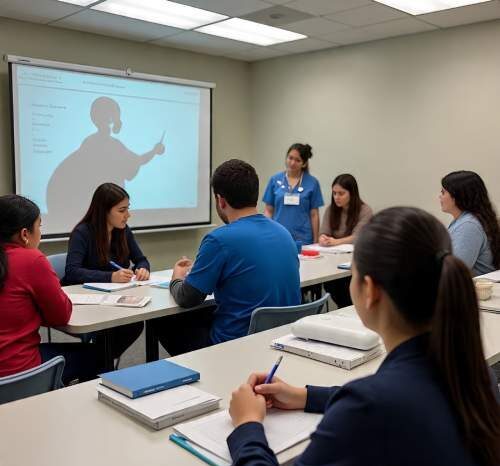Best Guide: International Nursing Teaching Strategies for ESL Students 2025

As global healthcare becomes increasingly interconnected, nursing classrooms in 2025 are more diverse than ever before. Nurse educators now frequently teach students for whom English is a second language (ESL), which presents both challenges and opportunities in clinical and academic settings.

This makes it essential to apply effective and inclusive approaches that ensure every learner thrives. In this context, the best guide to Teaching Strategies for ESL Students 2025 is not just about improving English proficiency, but also about building confidence, fostering cultural understanding, and preparing international students to excel in nursing practice.
Unlike general ESL instruction, nursing education requires mastery of specialized medical terminology, patient communication skills, and critical thinking in high-stakes environments. Without tailored strategies, language barriers can hinder comprehension, slow down skill acquisition, and affect overall performance. However, with the right teaching methods—ranging from technology-enhanced learning tools to culturally sensitive classroom practices—nurse educators can empower ESL students to succeed alongside their peers.
This article provides a comprehensive roadmap for nurse educators who want to implement the best international nursing teaching strategies for ESL students in 2025. We will explore innovative approaches such as simulation-based training, AI-powered language tools, peer learning models, and visual aids that support comprehension. At the same time, we will highlight best practices for fostering inclusion, reducing anxiety, and bridging linguistic gaps in clinical training environments.
Whether you are a nurse educator in North America, Europe, Asia, or the Middle East, these strategies are adaptable across cultural and educational contexts. By combining evidence-based teaching techniques with empathy and innovation, you can help ESL nursing students develop not only the technical knowledge they need but also the communication and confidence to deliver safe, effective patient care worldwide.
Why Specialized Teaching Strategies Are Essential for ESL Nursing Students in 2025
Teaching nursing students who are English as a Second Language (ESL) learners requires more than traditional instructional methods. By 2025, the global demand for nurses has led to classrooms filled with students from diverse linguistic and cultural backgrounds. While this diversity enriches the learning environment, it also introduces unique challenges that educators must address through targeted strategies.
1. Complex Medical Terminology
Nursing students must master highly technical vocabulary, much of which has no direct equivalent in other languages. Without tailored support, ESL students may struggle with understanding medical jargon, impacting their ability to apply knowledge in clinical practice.
2. High-Stakes Communication
Nurses communicate daily with patients, families, and healthcare teams. ESL learners need strategies that strengthen both listening and speaking skills to ensure they can respond quickly and effectively in critical healthcare settings.
3. Cultural Barriers
Beyond language, ESL nursing students often navigate cultural differences in healthcare practices and patient expectations. Educators must adopt culturally sensitive teaching strategies that prepare students for global nursing roles.
4. Exam and Licensing Preparation
International nursing students often face standardized exams (like NCLEX, IELTS, or OET) in English. Specialized strategies help them bridge language gaps while developing the test-taking skills needed to succeed.
5. Building Confidence and Reducing Anxiety
Language barriers can make students feel isolated or hesitant to participate in discussions. Educators who apply intentional strategies foster inclusivity, boost self-confidence, and encourage active learning.
By addressing these areas, nurse educators not only enhance academic outcomes but also equip ESL students with the tools needed to excel in real-world patient care. Effective teaching strategies ensure that language differences do not become barriers to nursing excellence in 2025 and beyond.
Key Challenges Faced by ESL Nursing Students
For nurse educators to design effective Teaching Strategies for ESL Students 2025, it is important to first understand the challenges that these learners commonly face.

These challenges extend beyond language proficiency and can significantly impact academic success, clinical performance, and overall confidence.
1. Language Barriers in Medical Terminology
Medical and nursing vocabulary is dense, technical, and often unfamiliar. ESL students may struggle to understand instructions, read textbooks, or follow clinical guidelines without additional support.
2. Difficulty in Clinical Communication
In healthcare, communication errors can have serious consequences. ESL nursing students often find it challenging to interact with patients, understand accents, or respond under pressure in fast-paced clinical settings.
3. Cultural Adjustment
Students from different countries may encounter cultural differences in patient care approaches, classroom dynamics, or professional expectations. This adjustment period can lead to confusion or hesitation in applying nursing practices.
4. Limited Participation in Classroom Discussions
Language barriers and fear of making mistakes can discourage ESL learners from speaking up in class, reducing their opportunities to practice communication and critical thinking.
5. Test-Taking Challenges
Exams like NCLEX, IELTS, or OSCEs demand not only nursing knowledge but also strong English reading and comprehension skills. ESL students often struggle with time management and understanding complex exam questions.
6. Stress and Self-Confidence Issues
Many ESL students face anxiety about being misunderstood or judged. This can affect their willingness to engage, collaborate with peers, or take leadership roles during group activities.
By recognizing these challenges, nurse educators can design targeted teaching strategies that go beyond simple language instruction, addressing both academic and emotional needs of ESL learners in 2025.
Best Teaching Strategies for ESL Nursing Students in 2025
Overcoming the challenges faced by ESL nursing students requires intentional, flexible, and culturally responsive teaching methods.

The following Teaching Strategies for ESL Students 2025 have proven effective in enhancing learning outcomes and preparing students for both exams and real-world clinical practice.
1. Simplify and Clarify Medical Terminology
Break down complex terms into simpler explanations, use visual aids like diagrams or flashcards, and encourage students to create bilingual glossaries to reinforce retention.
2. Use Simulation-Based Learning
High-fidelity simulations and role-play scenarios allow ESL students to practice communication and clinical skills in safe environments, reducing anxiety before entering real patient care settings.
3. Leverage Technology and AI Tools
AI-powered translation apps, speech-recognition software, and online medical dictionaries help bridge language gaps instantly while promoting independent learning.
4. Peer Mentorship Programs
Pair ESL students with fluent English-speaking peers for group projects, study sessions, and clinical practice. This not only improves language skills but also builds confidence and collaboration.
5. Active Learning Techniques
Incorporate group discussions, case studies, and interactive quizzes to encourage participation. Repetition and varied activities enhance comprehension and long-term memory.
6. Culturally Inclusive Teaching Approaches
Respect and integrate cultural perspectives into lessons, ensuring students feel valued and supported. This fosters inclusivity and helps learners apply nursing care within diverse patient populations.
7. Scaffolded Learning Support
Gradually increase the complexity of assignments, starting with simple tasks and building toward advanced concepts. This approach reduces overwhelm while ensuring steady progress.
8. Encourage Reflective Practice
Journaling, group debriefings, and reflective discussions help ESL nursing students process experiences, develop critical thinking, and strengthen their ability to articulate thoughts in English.
By combining these strategies, nurse educators can create an environment where ESL students thrive academically, clinically, and socially—ultimately ensuring that language differences do not stand in the way of nursing excellence in 2025.
Best IELTS Preparation Apps for Students in 2025
Role of Technology in Supporting ESL Nursing Students
In 2025, integrating Technology and AI in Teaching Strategies for ESL Students has become a cornerstone of effective nursing education. Digital tools not only enhance language comprehension but also provide interactive learning experiences that help ESL students bridge the gap between theory and practice.
1. AI-Powered Language Tools
Applications powered by artificial intelligence can translate medical terms, provide pronunciation guidance, and offer real-time feedback on written and spoken English. This personalized support accelerates language acquisition while reducing frustration.
2. Online Learning Platforms
Learning management systems (LMS) and e-learning platforms allow ESL students to access lectures, practice exams, and instructional videos at their own pace. These platforms also support interactive features like discussion forums, quizzes, and virtual simulations.
3. Simulation and Virtual Reality (VR)
VR and simulation labs replicate clinical environments, enabling students to practice patient interactions, procedures, and communication skills safely. ESL learners benefit from repeated practice without the pressure of real-life patient care.
4. Gamified Learning
Interactive games and quizzes make learning medical terminology, pharmacology, and procedures more engaging. Gamification reinforces knowledge retention while encouraging active participation.
5. Collaborative Tools
Video conferencing, shared documents, and online study groups facilitate collaboration among ESL and non-ESL students, promoting peer learning, cultural exchange, and improved communication skills.
6. Analytics and Progress Tracking
AI-driven analytics can monitor individual student performance, highlight language weaknesses, and suggest personalized study plans, allowing educators to provide targeted support.
By strategically leveraging technology, nurse educators can create a supportive, interactive, and inclusive learning environment where ESL students can excel academically and clinically. Technology acts as both a bridge and a scaffold, ensuring language barriers do not impede nursing competence and confidence.
Top 10 Best NCLEX Study Guide Books for 2025: Reviews and Pass-Rate Tips
Assessing and Evaluating ESL Nursing Students Effectively
Evaluation is a critical component of nursing education, but assessing ESL students requires thoughtful strategies to ensure fairness, accuracy, and skill mastery.

By implementing targeted methods, nurse educators can measure both language proficiency and clinical competence without disadvantaging non-native English speakers.
1. Use Multiple Assessment Methods
Combine written exams, oral presentations, practical demonstrations, and simulation-based assessments. This approach captures a holistic view of student learning and minimizes language bias.
2. Simplify Instructions and Clarify Expectations
Provide clear, concise instructions for assignments and exams. Using visual cues, step-by-step guides, and examples helps ESL students understand what is expected and reduces anxiety.
3. Formative Assessments for Continuous Feedback
Frequent low-stakes quizzes, reflection journals, and practice simulations allow students to receive ongoing feedback. This encourages improvement and builds confidence before high-stakes evaluations.
4. Peer and Self-Assessment
Encourage students to assess their own and their peers’ performance. This promotes critical thinking, self-awareness, and language practice while fostering collaborative learning.
5. Focus on Competency, Not Just Language
Ensure assessments emphasize clinical skills, critical thinking, and decision-making rather than penalizing minor language errors. This aligns evaluation with the ultimate goal of safe, effective patient care.
6. Use Technology to Support Assessment
Online platforms can provide instant grading, performance analytics, and adaptive testing tailored to each student’s strengths and weaknesses, offering objective and data-driven insights.
By applying these strategies, nurse educators can fairly evaluate ESL students while supporting their growth in both language proficiency and clinical competence, ensuring they are fully prepared for real-world nursing practice in 2025.
Tips for Enhancing Engagement and Participation of ESL Students
Active engagement is crucial for ESL nursing students to fully grasp course material, develop critical thinking, and build confidence in clinical settings. By using intentional strategies, educators can create an inclusive and interactive learning environment in 2025.
1. Encourage Small Group Discussions
Breaking students into small, diverse groups promotes interaction and reduces the intimidation some ESL learners feel in large classes. This setting allows more opportunities to ask questions, practice language skills, and build peer relationships.
2. Use Visual Aids and Multimedia
Charts, diagrams, videos, and interactive slides can help ESL students understand complex concepts without relying solely on verbal explanations. Visual learning reinforces comprehension and retention.
3. Implement Active Learning Techniques
Case studies, role-playing, and simulation exercises engage students in hands-on learning, fostering critical thinking and practical application of nursing knowledge.
4. Provide Opportunities for Repetition and Practice
Repeating key concepts and skills through drills, practice labs, and online exercises helps ESL students reinforce learning while gaining confidence.
5. Integrate Technology for Interactive Learning
Digital platforms, gamified exercises, and AI language tools can create dynamic learning experiences, encouraging participation and making content more accessible.
6. Foster a Supportive Classroom Culture
Encourage questions, celebrate small successes, and provide positive reinforcement. Reducing fear of mistakes builds confidence and motivates ESL students to participate actively.
7. Tailor Feedback to Individual Needs
Provide constructive, personalized feedback that addresses both language and clinical performance. Feedback should be encouraging, actionable, and culturally sensitive.
By implementing these engagement strategies, nurse educators can help ESL students become confident, active participants in their education, ensuring they acquire the skills and knowledge necessary for successful nursing practice in 2025.
Resilience Nursing Programs: Powerful Strategies for Nurse Resilience and Mental Health 2025
Conclusion – Preparing ESL Nursing Students for Success in 2025
Teaching ESL nursing students requires a combination of cultural sensitivity, language support, and evidence-based instructional strategies. By implementing the Teaching Strategies for ESL Students 2025, nurse educators can bridge language barriers, enhance comprehension, and foster confidence in both academic and clinical settings.
Effective strategies—including simulation-based learning, technology integration, peer mentorship, and active learning techniques—ensure that ESL students are not only keeping pace with their peers but also developing the critical skills needed for safe and competent patient care. Emphasizing inclusivity, continuous feedback, and practical application helps learners thrive academically while preparing them for real-world healthcare environments.
As classrooms become increasingly diverse, the role of nurse educators is evolving. By embracing innovative strategies and leveraging technology, educators can transform challenges into opportunities, empowering ESL nursing students to succeed in exams, clinical practice, and future careers. The ultimate goal is to ensure that language differences do not impede nursing excellence, preparing graduates to deliver high-quality care anywhere in the world.
Resources & References
To enhance the implementation of Teaching Strategies for ESL Students 2025, nurse educators can rely on these authoritative resources and organizations:
-
World Health Organization (WHO) – Nursing and Midwifery Education
https://www.who.int/health-topics/nursing
(Global guidance on nursing education standards and inclusive teaching practices.) -
National League for Nursing (NLN)
https://www.nln.org
(Resources on faculty development, ESL teaching strategies, and simulation-based learning.) -
American Association of Colleges of Nursing (AACN)
https://www.aacnnursing.org
(Standards and innovative approaches for nursing education and curriculum development.) -
International Council of Nurses (ICN) – Nursing Education
https://www.icn.ch
(Guidance on global nursing education practices and diversity inclusion.) -
Journal of Nursing Education and Practice (JNEP)
https://jnep.sciedupress.com
(Evidence-based research on ESL teaching methods and clinical training.) -
Elsevier – Nursing Education Resources
https://www.elsevier.com
(Articles, case studies, and teaching tools for ESL and international nursing students.)
These resources provide valuable insights, evidence-based practices, and practical tools to help educators effectively support ESL nursing students and improve learning outcomes in 2025.
Frequently Asked Questions (FAQs)
ESL nursing students face language barriers, cultural differences, and complex medical terminology. Tailored strategies help them succeed academically and clinically.
AI tools, simulation software, VR, and online learning platforms enhance comprehension, practice, and engagement while bridging language gaps.
Simulation-based learning, peer mentorship, active learning techniques, visual aids, and scaffolded instruction are highly effective.
Use multiple assessment methods, focus on competency over minor language errors, provide clear instructions, and offer continuous formative feedback.
Small group discussions, gamified learning, culturally inclusive teaching, and personalized feedback encourage active participation and confidence.
Yes, with targeted language support, exam preparation strategies, and practice in medical terminology, ESL students can excel in exams like NCLEX, IELTS, or OET.
Cultural sensitivity ensures inclusivity, builds trust, and helps students apply nursing skills appropriately in diverse healthcare settings.


